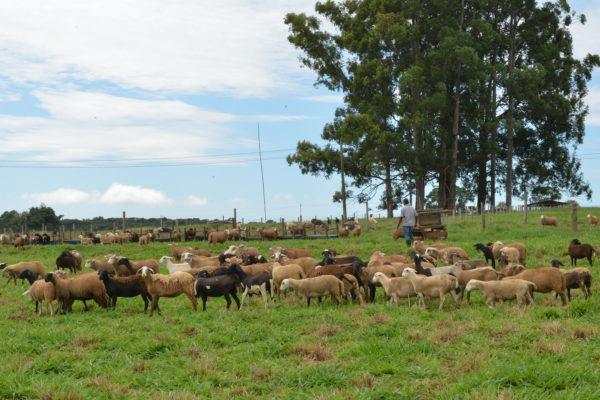(MENAFN- Brazil-Arab News Agency (ANBA))

São Paulo – Herds of goats and sheep in Brazil are still small compared to the largest in the world; however, a recent decision by the Saudi Arabian government could boost production. Following a visit by Brazil's Minister of Agriculture and Livestock, Carlos Fávaro, to the Gulf country in late July this year, the local government opened its market for sheep and goat meat from Brazil.
According to data from the United Nations Food and Agriculture Organization (FAO), in 2020, the apparent consumption of sheep meat in Saudi Arabia was 109,540 tonnes. For goat meat, consumption was 56,630 tonnes. Apparent consumption is the total production of a good, plus imports subtracted by exports. That is the total of the product that remains in the country.
According to the Ministry of Agriculture and Livestock of Brazil, the sanitary agreement signed between the two countries includes exports of meat and byproducts from sheep, rams, lambs, and goats. For the president of the Brazilian Association of Sheep Breeders (ARCO), Edemundo Ferreira Gressler, the opening of this market is an excellent opportunity for Brazil; nevertheless, the small herd makes it difficult to meet local and international demand.
“This well-established market is without a shadow of a doubt a big step forward in the international expansion, which is considered extremely favorable, but it will only be consolidated once we have an increase in the herd,” said Gressler.
He said the Brazilian sheep herd (pictured above) has 20.5 million heads, and the majority of production is in the Northeast region. About 12 million heads are in that region, most of them hair sheep (breeds that do not produce wool) and are raised for slaughter and meat production, such as the Santa Inês breed. According to Gressler, there is potential to expand production in the country. The breeds raised in the South of Brazil are wool sheep. Some of them are used in the production of textiles. Others can be used to produce lower-quality wool and meat.
Gressler said that, for production to increase, plants could produce halal meat (in accordance with the traditions of Islam), and to enable large-scale exports, investments from the federal and state governments are necessary. He mentioned export logistics as a challenge, for instance.“[Increased production capacity and halal production] are consolidated because from the moment a new market appears, with significant value, it becomes profitable and attractive. And sheep really need an economically attractive market,” he said.
Goats
Challenges and opportunities also exist in another market opened by Saudi Arabia: Goats. In this case, the Brazilian herd is even smaller: 11.9 million heads, according to data from the 2021 Municipal Livestock Production Survey (PPM) carried out and made public by the Brazilian Institute of Geography and Statistics (IBGE). The Brazilian goat herd is also concentrated in the Northeast.
According to the supervisor of the Prospecting and Technology Assessment Management Sector of the Brazilian Agricultural Research Corporation (Embrapa) Goats and Sheep division, Vitor Coutinho dos Santos, the expansion of the goat market could follow the same steps as the sheep.“We noticed that slaughterhouses and processing plants are increasingly technically prepared and have the appropriate health and quality certifications to access local, national, and international markets,” said Santos. He explained that monitoring carried out by Embrapa's Goat and Sheep Intelligence Center has identified an increase in demand for goat meat in the Southeast; still, only a small number of plants are prepared to meet the demand, which makes the challenge even more difficult for growing demand from the international market.
FAO data cited by Embrapa shows Brazil holds the 21st-largest global goat herd. The world's biggest herd belongs to India, with 148.7 million heads, followed by China, Pakistan, Nigeria, and Bangladesh. Exports of goats and their byproducts from 2018 to 2022 totaled USD 7.2 million, of which USD 96,200 were meat, reported the Socioeconomic Department researcher of Embrapa Goats and Sheep, Klinger Aragão Magalhães. The majority of export revenue came from goat skins and hides.
Also citing FAO data, Magalhães said the leading global importers of goat meat are the United States, the United Arab Emirates, China, the Republic of Korea, and Saudi Arabia, and the largest global exporters of goat meat are Australia, Ethiopia, Kenya, New Zealand, and France.
Embrapa Goats and Sheep analyst Zenildo Ferreira Holanda Filho observed the export process needs to start with improvements in local production, such as identifying potential herds and improving the quality and standardization of products according to buyer demand.
“It is necessary to consider the tiny current number of slaughtering structures duly accredited by the Ministry of Agriculture and Livestock to produce goat meat for export and whether these plants are located where the logistics of shipping to slaughter are economically practical. In this logic, the intention to export goat meat today must be unconditionally accompanied by robust medium and long-term government stimuli to facilitate and encourage complementary actions by the private sector,” he said.
Translated by Elúsio Brasileiro
Lilian Alves/Embrapa
The post Saudi market opening could boost sheep production in Brazil appeared first on Agência de Notícias Brasil-Árabe .
MENAFN10102023000213011057ID1107221144
Legal Disclaimer:
MENAFN provides the information “as is” without warranty of any kind. We do not accept any responsibility or liability for the accuracy, content, images, videos, licenses, completeness, legality, or reliability of the information contained in this article. If you have any complaints or copyright issues related to this article, kindly contact the provider above.